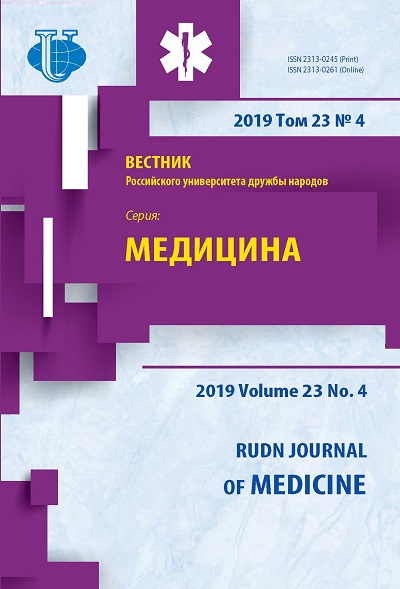Morphology of GFAP-Positive Cells in Male and Female Rats’ Cerebral Cortex during the Cerebral Hypoxia Development according to the Stress Tolerance Level
- Authors: Chrishtop V.V.1,2, Rumyanceva T.A.3, Pozhilov D.A.3
-
Affiliations:
- Ivanovo State Medical Academy
- Saint Petersburg National Research University of Information Technologies, Mechanics and Optics
- Yaroslavl State Medical University
- Issue: Vol 23, No 4 (2019)
- Pages: 397-404
- Section: BIOLOGY. EXPERIMENTAL PHYSIOLOGY
- URL: https://journals.rudn.ru/medicine/article/view/22800
- DOI: https://doi.org/10.22363/2313-0245-2019-23-4-397-404
Cite item
Full Text
Abstract
Correlation between individual typological features like sex-related characteristics and low initial level of stress resistance and unfavorable prognosis of ischemic brain damage is shown. At the same time, the astrocytes’ participation in neuroplasticity in this disease represents the purpose of the study. The goal was to study the cerebral cortex astrocytes’ morphometric characteristics during the cerebral hypoxia in rats of different sexes with different stress tolerance levels. We performed the study with 72 Wistar rats. According to the Open Field test results all the animals were divided into two subgroups: with high and low level of stress tolerance. Both carotid arteries of the experimental group animals (48 animals) were bandaged. Animals were removed from the experiment at 21, 60 and 90 days after surgery. Glial fibrillary acidic protein (GFAP), a marker of mature astrocytes, was detected on histological sections of the central brain gyrus using primary polyclonal rabbit antibodies. Progressive decrease of the astrocytes’ numerical density and the number of first order processes were obtained during the study. It was less pronounced in animals with high stress tolerance and females. Increase of the processes’ distribution area was reliably detected. Area decreased after 90th day of the experiment. It is concluded that the astrocytes’ alteration develops earlier in animals with high stress tolerance and males, later in females (60 days) and animals with low stress tolerance (90 days).
Keywords
About the authors
V. V. Chrishtop
Ivanovo State Medical Academy; Saint Petersburg National Research University of Information Technologies, Mechanics and Optics
Author for correspondence.
Email: chrishtop@mail.ru
Ivanovo, Russian Federation; Saint Petersburg , Russian Federation
T. A. Rumyanceva
Yaroslavl State Medical University
Email: chrishtop@mail.ru
Yaroslavl, Russian Federation
D. A. Pozhilov
Yaroslavl State Medical University
Email: chrishtop@mail.ru
Yaroslavl, Russian Federation
References
- Antipenko EA, Gustov AV. Individual stress resistance and prognosis of disease in the case of chronic ishemia of brain. Meditsinskiy almanakh. 2014;3(33): 36—38. (In Russ.).
- Kryzhanovsky GN. Disregulation pathology: a guide for physicians and biologists. Moscow: Meditsina; 2002: 260—270. (In Russ.).
- Zarubina IV. Molecular mechanisms of individual hypoxia resistance. Reviews on clinical pharmacology and drug therapy. 2005;4(1): 49—51. (In Russ.).
- Jov M, Portero-Otin M, Naudi A, Ferrer I, Pamplona R. Metabolomics of human brain aging and age-related neurodegenerative diseases. J Neuropathol Exp Neurol. 2014;73(7): 640—57.
- Chen X, Zhang X, Liao W, Wan Q, Effect of physical and social components of enriched environment on astrocytes proliferation in rats after cerebral ischemia/reperfusion injury. Neurochem Res. 2017;42(5): 1308—16.
- Bon EI, Maksimovich NE. Methods of modeling and morphofunctional markers of cerebral ischemia. Biomedicine. 2018;(2): 59—71. (In Russ.).
- Chrishtop VV, Pakhrova OA, Rumyantseva TA. Dynamics of permanent cerebral hypoxia of rats depending on individual features of higher nervous activity and sex. Medical news of the north caucasus. 2018;13(4): 654—9. (In Russ.).
- Morken TS, Brekke E, Håberg A, Widerøe M, Brubakk AM, Sonnewald U. Altered astrocyte-neuronal interactions after hypoxia-ischemia in the neonatal brain in female and male rats. Stroke. 2014 Sep; 45(9): 2777—85. doi: 10.1161/Strokeaha.114.005341.
- Deputat IS, Bolshevidtseva IL. Brain energy metabolism in elderly women with a high level of anxiety: factor analysis // In the collection: Clinical, biological, psychological aspects of psychiatry and narcology materials of an interregional scientific-practical conference with international participation edited by D.M. Ivashinenko. 2016. 19 p. (In Russ.).
- Shvalev VN, Sosunov AA, Chelyshev Yu.A. Astrocytes and plasticity of synapses. Part I. Synaptogenic molecules // Neurological Bulletin. 2018;50(2): 55—60. (In Russ.).
















